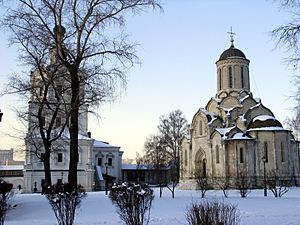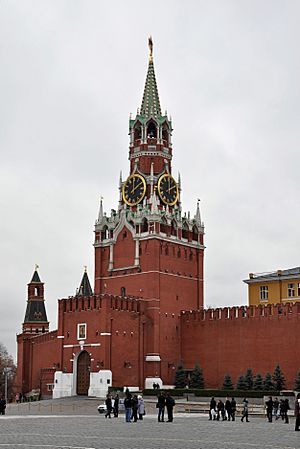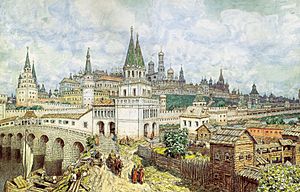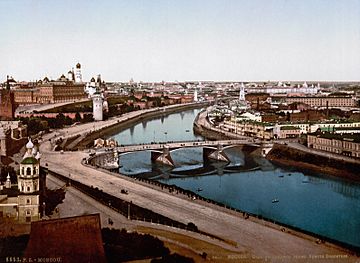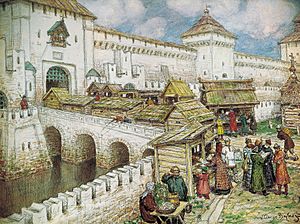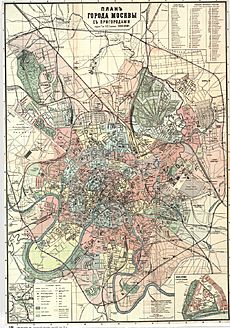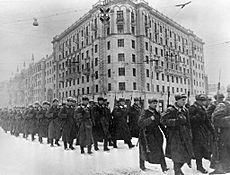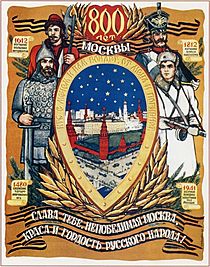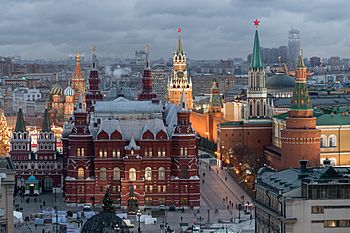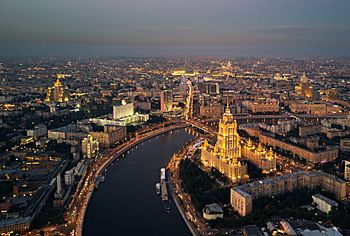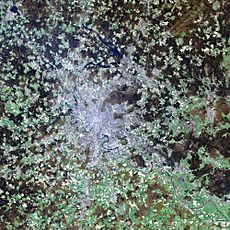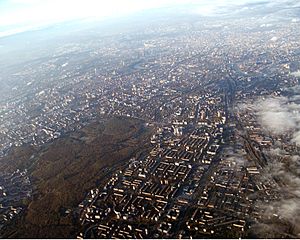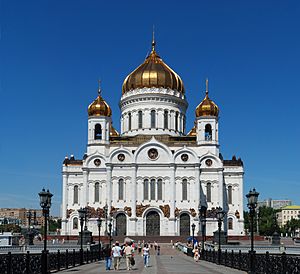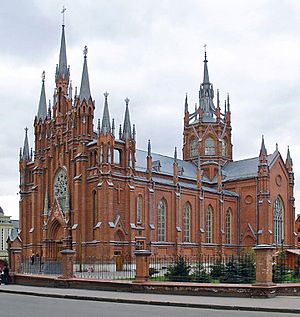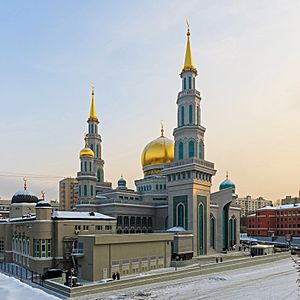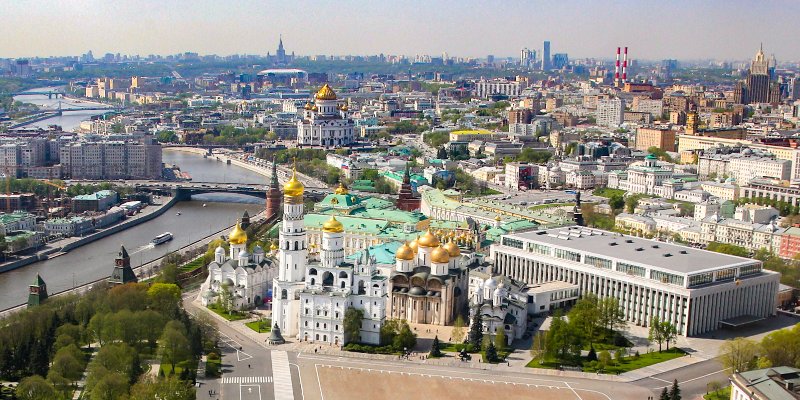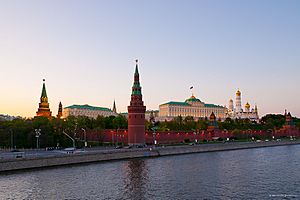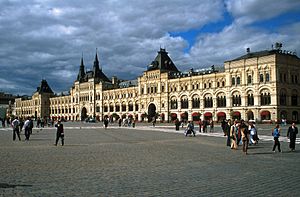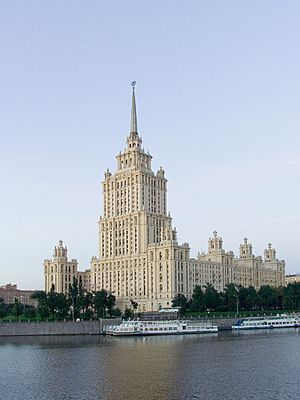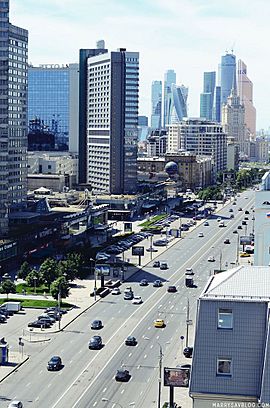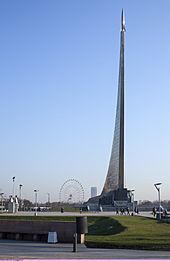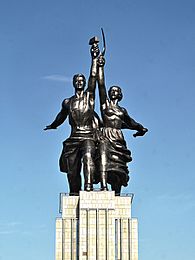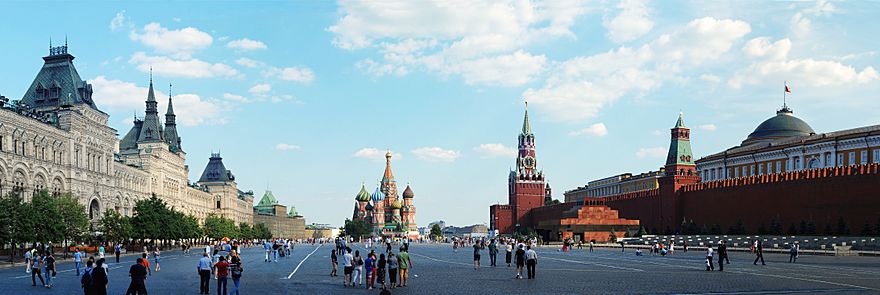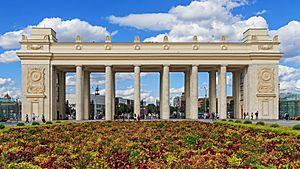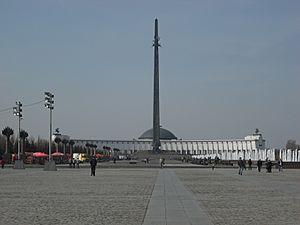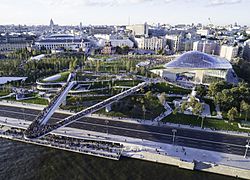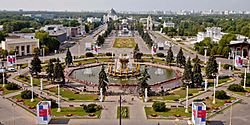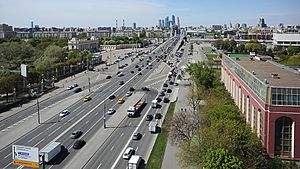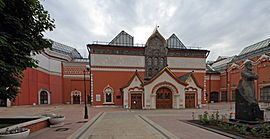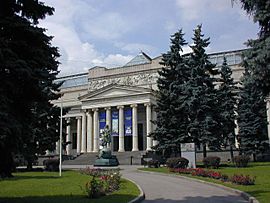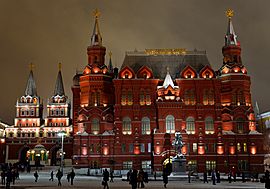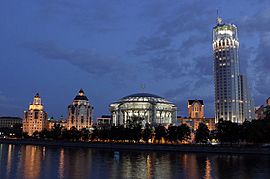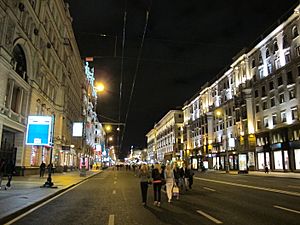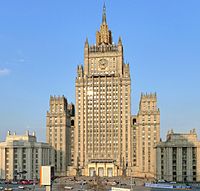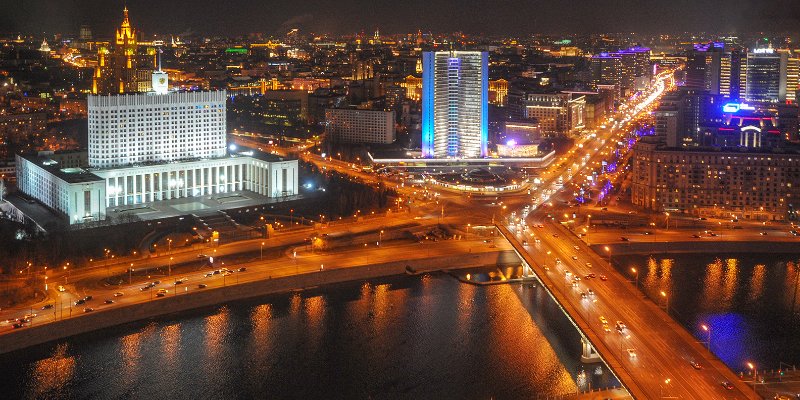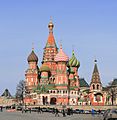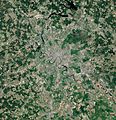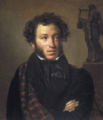Moscow facts for kids
Quick facts for kids
Moscow
Москва
|
|
|---|---|
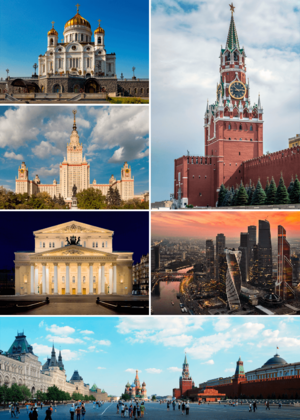
Clockwise, from top right: Spasskaya Tower of the Moscow Kremlin; MIBC; Red Square, Saint Basil's Cathedral; Bolshoi Theatre; Moscow State University; and Cathedral of Christ the Saviour.
|
|
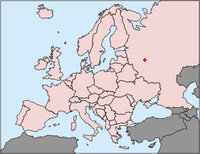
Moscow is here
|
|
| Founded | 1147 |
| Area | |
| • Total | 1,081 km2 (417.4 sq mi) |
| Elevation
(
|
156 m (512 ft) |
| Population
(1 June 2009)
|
|
| • Total | 10,126,424 |
| • Density | 9,367.6/km2 (24,262/sq mi) |
| Time zone | UTC+3 (Moscow Time) |
| • Summer (DST) | UTC+4 (Moscow Summer Time) |
Moscow (Russian: Москва, "Moskva") is the capital city of Russia. 11.5 million people live there (since 1 October 2010), so it is Europe's biggest city. It is also the seventh biggest city in the world. Moscow is an important political, cultural, economic, religious, financial and transportation center. It is a global city, important in the economic infrastructure of the region. Moscow was founded by Prince Yuri Dolgoruki in 1147.
The middle of the city is an ancient walled city called the Kremlin. There are important government buildings, museums and churches in the Kremlin. Many of the buildings in Moscow, like St. Basil's Cathedral and Spasskaya Tower, are very beautiful and famous. There are also modern buildings. The many art galleries have big collections.
Moscow has many scientific and educational buildings, as well as some sports complexes built for the 1980 Summer Olympics. Transport includes four international airports, nine railroad stations and the second busiest (after Tokyo) metro system in the world, which is famous for its artwork.
Over time, the city has earned a variety of nicknames, most referring to its pre-eminent status in the nation: The Third Rome (Третий Рим), Whitestone (Белокаменная), The First Throne (Первопрестольная), The Forty Forties (Сорок Сороков.)
A person from Moscow is called a Muscovite in English, or a Moskvich in Russian.
Contents
History
Prehistory
The oldest evidence of humans on the territory of Moscow dates from the Neolithic (Schukinskaya site on the Moscow River). Within the modern bounds of the city other late evidence was discovered (the burial ground of the Fatyanovskaya culture, the site of the Iron Age settlement of the Dyakovo culture), on the territory of the Kremlin, Sparrow Hills, Setun River and Kuntsevskiy forest park, etc.
In the 9th century, the Oka River was part of the Volga trade route, and the upper Volga watershed became an area of contact between the indigenous Finno-Ugric such as the Merya and the expanding Volga Bulgars (particularly the second son of Khan Kubrat who expanded the borders of the Old Great Bulgaria), Scandinavian (Varangians) and Slavic peoples.
The earliest East Slavic tribes recorded as having expanded to the upper Volga in the 9th to 10th centuries are the Vyatichi and Krivichi. The Moskva River was incorporated as part of Kievan Rus into the Suzdal in the 11th century. By AD 1100, a minor settlement had appeared on the mouth of the Neglinnaya River.
Early history (1147–1283)
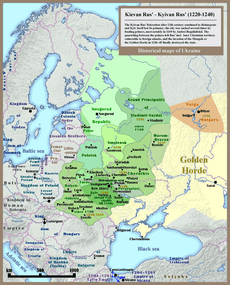
The first known reference to Moscow dates from 1147 as a meeting place of Yuri Dolgoruky and Sviatoslav Olgovich. At the time it was a minor town on the western border of Vladimir-Suzdal Principality.
In 1156, Knjaz Yury Dolgoruky fortified the town with a timber fence and a moat. In the course of the Mongol invasion of Rus, the Mongols under Batu Khan burned the city to the ground and killed its inhabitants.
The timber fort na Moskvě "on the Moscow river" was inherited by Daniel, the youngest son of Alexander Nevsky, in the 1260s, at the time considered the least valuable of his father's possessions. Daniel was still a child at the time, and the big fort was governed by tiuns (deputies), appointed by Daniel's paternal uncle, Yaroslav of Tver.
Daniel came of age in the 1270s and became involved in the power struggles of the principality with lasting success, siding with his brother Dmitry in his bid for the rule of Novgorod. From 1283 he acted as the ruler of an independent principality alongside Dmitry, who became Grand Duke of Vladimir. Daniel has been credited with founding the first Moscow monasteries, dedicated to the Lord's Epiphany and to Saint Daniel.
Grand Duchy (1283–1547)
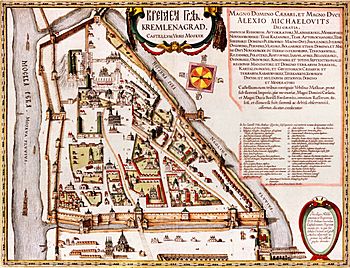 |
 |
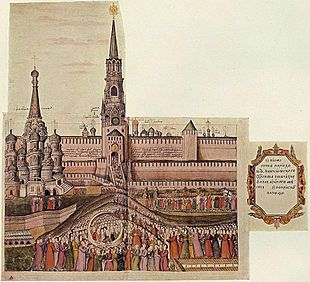 |
| Moscow Kremlin in the late 16th century | Siege of Moscow (1382) | Red Square |
Daniel I ruled Moscow as Grand Duke until 1303 and established it as a prosperous city that would eclipse its parent principality of Vladimir by the 1320s.
On the right bank of the Moskva River, at a distance of five miles (8.0 kilometres) from the Kremlin, not later than in 1282, Daniel founded the first monastery with the wooden church of St. Daniel-Stylite. Now it is the Danilov Monastery. Daniel died in 1303, at the age of 42. Before his death he became a monk and, according to his will, was buried in the cemetery of the St. Daniel Monastery.
Moscow was stable and prosperous for many years and attracted a large number of refugees from across Russia. The Rurikids maintained large landholdings by practicing primogeniture, whereby all land was passed to the eldest sons, rather than dividing it up among all sons. By 1304, Yury of Moscow contested with Mikhail of Tver for the throne of the principality of Vladimir. Ivan I eventually defeated Tver to become the sole collector of taxes for the Mongol rulers, making Moscow the capital of Vladimir-Suzdal. By paying high tribute, Ivan won an important concession from the Khan.
While Khan of the Golden Horde initially attempted to limit Moscow's influence, when the growth of the Grand Duchy of Lithuania began to threaten all of Russia, the Khan strengthened Moscow to counterbalance Lithuania, allowing it to become one of the most powerful cities in Russia. In 1380, prince Dmitry Donskoy of Moscow led a united Russian army to an important victory over the Mongols in the Battle of Kulikovo. Afterwards, Moscow took the leading role in liberating Russia from Mongol domination. In 1480, Ivan III had finally broken the Russians free from Tatar control, and Moscow became the capital of an empire that would eventually encompass all of Russia and Siberia, and parts of many other lands.
In 1462 Ivan III, (1440–1505) became Grand Prince of Moscow (then part of the medieval Muscovy state). He began fighting the Tatars, enlarged the territory of Muscovy, and enriched his capital city. By 1500 it had a population of 100,000 and was one of the largest cities in the world. He conquered the far larger principality of Novgorod to the north, which had been allied to the hostile Lithuanians. Thus he enlarged the territory sevenfold, from 430,000 to 2,800,000 square kilometres (170,000 to 1,080,000 square miles). He took control of the ancient "Novgorod Chronicle" and made it a propaganda vehicle for his regime.
The original Moscow Kremlin was built during the 14th century. It was reconstructed by Ivan, who in the 1480s invited architects from Renaissance Italy, such as Petrus Antonius Solarius, who designed the new Kremlin wall and its towers, and Marco Ruffo who designed the new palace for the prince. The Kremlin walls as they now appear are those designed by Solarius, completed in 1495. The Kremlin's Great Bell Tower was built in 1505–08 and augmented to its present height in 1600.
A trading settlement, or posad, grew up to the east of the Kremlin, in the area known as Zaradye (Зарядье). In the time of Ivan III, the Red Square, originally named the Hollow Field (Полое поле) appeared.
In 1508–1516, the Italian architect Aleviz Fryazin (Novy) arranged for the construction of a moat in front of the eastern wall, which would connect the Moskva and Neglinnaya and be filled in with water from Neglinnaya. This moat, known as the Alevizov moat and having a length of 541 metres (1,775 feet), width of 36 metres (118 feet), and a depth of 9.5 to 13 metres (31–43 feet) was lined with limestone and, in 1533, fenced on both sides with low, four-metre-thick (13-foot) cogged-brick walls.
Tsardom (1547–1721)
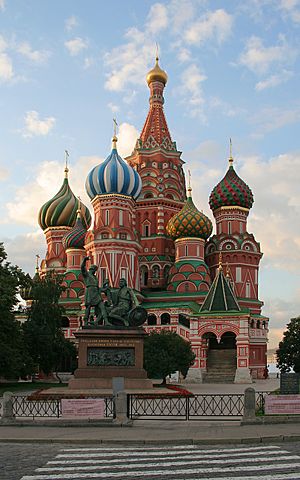
In the 16th and 17th centuries, the three circular defences were built: Kitay-gorod (Китай-город), the White City (Белый город) and the Earthen City (Земляной город). However, in 1547, two fires destroyed much of the town, and in 1571 the Crimean Tatars captured Moscow, burning everything except the Kremlin. The annals record that only 30,000 of 200,000 inhabitants survived.
The Crimean Tatars attacked again in 1591, but this time were held back by new defence walls, built between 1584 and 1591 by a craftsman named Fyodor Kon. In 1592, an outer earth rampart with 50 towers was erected around the city, including an area on the right bank of the Moscow River. As an outermost line of defence, a chain of strongly fortified monasteries was established beyond the ramparts to the south and east, principally the Novodevichy Convent and Donskoy, Danilov, Simonov, Novospasskiy, and Andronikov monasteries, most of which now house museums. From its ramparts, the city became poetically known as Bielokamennaya, the "White-Walled". The limits of the city as marked by the ramparts built in 1592 are now marked by the Garden Ring.
Three square gates existed on the eastern side of the Kremlin wall, which in the 17th century, were known as: Konstantino-Eleninsky, Spassky, Nikolsky (owing their names to the icons of Constantine and Helen, the Saviour and St. Nicholas that hung over them). The last two were directly opposite the Red Square, while the Konstantino-Elenensky gate was located behind Saint Basil's Cathedral.
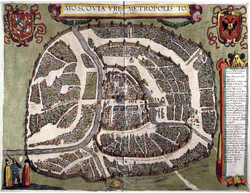
The Russian famine of 1601–03 killed perhaps 100,000 in Moscow. From 1610 through 1612, troops of the Polish–Lithuanian Commonwealth occupied Moscow, as its ruler Sigismund III tried to take the Russian throne. In 1612, the people of Nizhny Novgorod and other Russian cities conducted by prince Dmitry Pozharsky and Kuzma Minin rose against the Polish occupants, besieged the Kremlin, and expelled them. In 1613, the Zemsky sobor elected Michael Romanov tsar, establishing the Romanov dynasty. The 17th century was rich in popular risings, such as the liberation of Moscow from the Polish–Lithuanian invaders (1612), the Salt Riot (1648), the Copper Riot (1662), and the Moscow Uprising of 1682.
During the first half of the 17th century, the population of Moscow doubled from roughly 100,000 to 200,000. It expanded beyond its ramparts in the later 17th century. By 1682, there were 692 households established north of the ramparts, by Ukrainians and Belarusians abducted from their hometowns in the course of Russo-Polish War (1654–1667). These new outskirts of the city came to be known as the Meshchanskaya sloboda, after Ruthenian meshchane "town people". The term meshchane (мещане) acquired pejorative connotations in 18th-century Russia and today means "petty bourgeois" or "narrow-minded philistine".
The entire city of the late 17th century, including the slobodas that grew up outside the city ramparts, are contained within what is today Moscow's Central Administrative Okrug.
Numerous disasters befell the city. The plague epidemics ravaged Moscow in 1570–1571, 1592 and 1654–1656. The plague killed upwards of 80% of the people in 1654–55. Fires burned out much of the wooden city in 1626 and 1648. In 1712 Peter the Great moved his government to the newly built Saint Petersburg on the Baltic coast. Moscow ceased to be Russia's capital, except for a brief period from 1728 to 1732 under the influence of the Supreme Privy Council.
Empire (1721–1917)
After losing the status as capital of the empire, the population of Moscow at first decreased, from 200,000 in the 17th century to 130,000 in 1750. But after 1750, the population grew more than tenfold over the remaining duration of the Russian Empire, reaching 1.8 million by 1915.
By 1700, the building of cobbled roads had begun. In November 1730, the permanent street light was introduced, and by 1867 many streets had a gaslight. In 1883, near the Prechistinskiye Gates, arc lamps were installed. In 1741 Moscow was surrounded by a barricade 25 miles (40 kilometres) long, the Kamer-Kollezhskiy barrier, with 16 gates at which customs tolls were collected. Its line is traced today by a number of streets called val (“ramparts”). Between 1781 and 1804 the Mytischinskiy water-pipe (the first in Russia) was built. In 1813, following the destruction of much of the city during French occupation, a Commission for the Construction of the City of Moscow was established. It launched a great program of rebuilding, including a partial replanning of the city-centre. Among many buildings constructed or reconstructed at this time were the Grand Kremlin Palace and the Kremlin Armoury, the Moscow University, the Moscow Manege (Riding School), and the Bolshoi Theatre. In 1903 the Moskvoretskaya water-supply was completed.
In the early 19th century, the Arch of Konstantino-Elenensky gate was paved with bricks, but the Spassky Gate was the main front gate of the Kremlin and used for royal entrances. From this gate, wooden and (following the 17th-century improvements) stone bridges stretched across the moat. Books were sold on this bridge and stone platforms were built nearby for guns – "raskats". The Tsar Cannon was located on the platform of the Lobnoye mesto.
The road connecting Moscow with St. Petersburg, now the M10 highway, was completed in 1746, its Moscow end following the old Tver road, which had existed since the 16th century. It became known as Peterburskoye Schosse after it was paved in the 1780s. Petrovsky Palace was built in 1776–1780 by Matvey Kazakov as a railway station specifically reserved for royal journeys from Saint Petersburg to Moscow, while coaches for lesser classes arrived and departed from Vsekhsvyatskoye station.
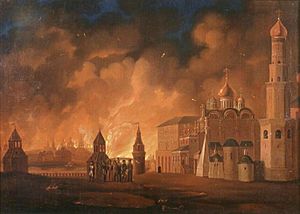
When Napoleon invaded Russia in 1812, the Moscovites were evacuated. It is suspected that the Moscow fire was principally the effect of Russian sabotage. Napoleon’s Grande Armée was forced to retreat and was nearly annihilated by the devastating Russian winter and sporadic attacks by Russian military forces. As many as 400,000 of Napoleon's soldiers died during this time.
Moscow State University was established in 1755. Its main building was reconstructed after the 1812 fire by Domenico Giliardi. The Moskovskiye Vedomosti newspaper appeared from 1756, originally in weekly intervals, and from 1859 as a daily newspaper.
The Arbat Street had been in existence since at least the 15th century, but it was developed into a prestigious area during the 18th century. It was destroyed in the fire of 1812 and was rebuilt completely in the early 19th century.
In the 1830s, general Alexander Bashilov planned the first regular grid of city streets north from Petrovsky Palace. Khodynka field south of the highway was used for military training. Smolensky Rail station (forerunner of present-day Belorussky Rail Terminal) was inaugurated in 1870. Sokolniki Park, in the 18th century the home of the tsar's falconers well outside Moscow, became contiguous with the expanding city in the later 19th century and was developed into a public municipal park in 1878. The suburban Savyolovsky Rail Terminal was built in 1902. In January 1905, the institution of the City Governor, or Mayor, was officially introduced in Moscow, and Alexander Adrianov became Moscow's first official mayor.
When Catherine II came to power in 1762, the city's filth and smell of sewage was depicted by observers as a symptom of disorderly life styles of lower-class Russians recently arrived from the farms. Elites called for improving sanitation, which became part of Catherine's plans for increasing control over social life. National political and military successes from 1812 through 1855 calmed the critics and validated efforts to produce a more enlightened and stable society. There was less talk about the smell and the poor conditions of public health. However, in the wake of Russia's failures in the Crimean War in 1855–56, confidence in the ability of the state to maintain order in the slums eroded, and demands for improved public health put filth back on the agenda.
Soviet era (1917–1991)
Following the success of the Russian Revolution of 1917, Vladimir Lenin, fearing possible foreign invasion, moved the capital from Saint Petersburg back to Moscow on March 5, 1918. The Kremlin once again became the seat of power and the political centre of the new state.
With the change in values imposed by communist ideology, the tradition of preservation of cultural heritage was broken. Independent preservation societies, even those that defended only secular landmarks such as Moscow-based OIRU were disbanded by the end of the 1920s. A new anti-religious campaign, launched in 1929, coincided with collectivization of peasants; destruction of churches in the cities peaked around 1932. In 1937 several letters were written to the Central Committee of the Communist Party of the Soviet Union to rename Moscow to "Stalindar" or "Stalinodar", one from an elderly pensioner whose dream was to "live in Stalinodar" and had selected the name to represent the "gift" (dar) of the genius of Stalin. Stalin rejected this suggestion, and after it was suggested again to him by Nikolai Yezhov, he was "outraged", saying "What do I need this for?". This was following Stalin banning the renaming of places in his name in 1936.
During the Great Patriotic War, the Soviet State Committee of Defence and the General Staff of the Red Army were located in Moscow. In 1941, 16 divisions of the national volunteers (more than 160,000 people), 25 battalions (18,000 people) and 4 engineering regiments were formed among the Muscovites. In November 1941, German Army Group Centre was stopped at the outskirts of the city and then driven off in the course of the Battle of Moscow. Many factories were evacuated, together with much of the government, and from October 20 the city was declared to be in a state of siege. Its remaining inhabitants built and manned antitank defences, while the city was bombarded from the air. On May 1, 1944 a medal "For the defence of Moscow" and in 1947 another medal "In memory of the 800th anniversary of Moscow" were instituted.
Both German and Soviet casualties during the battle of Moscow have been a subject of debate, as various sources provide somewhat different estimates. Total casualties between September 30, 1941, and January 7, 1942, are estimated to be between 248,000 and 400,000 for the Wehrmacht and between 650,000 and 1,280,000 for the Red Army.
During the postwar years, there was a serious housing crisis, solved by the invention of high-rise apartments. There are over 11,000 of these standardised and prefabricated apartment blocks, housing the majority of Moscow's population, making it by far the city with the most high-rise buildings. Apartments were built and partly furnished in the factory before being raised and stacked into tall columns. The popular Soviet-era comic film Irony of Fate parodies this construction method.
The city of Zelenograd was built in 1958 at 37 kilometres (23 miles) from the city centre to the north-west, along the Leningradskoye Shosse, and incorporated as one of Moscow's administrative okrugs. Moscow State University moved to its campus on Sparrow Hills in 1953.
In 1959 Nikita Khrushchev launched his anti-religious campaign. By 1964 over 10 thousand churches out of 20 thousand were shut down (mostly in rural areas) and many were demolished. Of 58 monasteries and convents operating in 1959, only sixteen remained by 1964; of Moscow's fifty churches operating in 1959, thirty were closed and six demolished.
On May 8, 1965 due to the actual 20th anniversary of the victory in World War II Moscow was awarded a title of the Hero City. In 1980 it hosted the Summer Olympic Games.
The MKAD (ring road) was opened in 1961. It had four lanes running 109 kilometres (68 miles) along the city borders. The MKAD marked the administrative boundaries of the city of Moscow until the 1980s, when outlying suburbs beyond the ring road began to be incorporated. In 1980, it hosted the Summer Olympic Games, which were boycotted by the United States and several other Western countries due to the Soviet Union's involvement in Afghanistan in late 1979. In 1991 Moscow was the scene of a coup attempt by conservative communists opposed to the liberal reforms of Mikhail Gorbachev.
Recent history (1991–present)
When the USSR was dissolved in the same year, Moscow remained the capital of the Russian SFSR (on December 25, 1991 the Russian SFSR was renamed the Russian Federation). Since then, a market economy has emerged in Moscow, producing an explosion of Western-style retailing, services, architecture, and lifestyles.
The city has continued to grow during the 1990s to 2000s, its population rising from below nine to above ten million. Mason and Nigmatullina argue that Soviet-era urban-growth controls (before 1991) produced controlled and sustainable metropolitan development, typified by the greenbelt built in 1935. Since then, however, there has been a dramatic growth of low-density suburban sprawl, created by a heavy demand for single-family dwellings as opposed to crowded apartments. In 1995–1997 the MKAD ring road was widened from the initial four to ten lanes. In December 2002 Bulvar Dmitriya Donskogo became the first Moscow Metro station that opened beyond the limits of MKAD. The Third Ring Road, intermediate between the early 19th-century Garden Ring and the Soviet-era outer ring road, was completed in 2004. The greenbelt is becoming more and more fragmented, and satellite cities are appearing at the fringe. Summer dachas are being converted into year-round residences, and with the proliferation of automobiles there is heavy traffic congestion. Multiple old churches and other examples of architectural heritage that had been demolished during the Stalin era have been restored, such as Cathedral of Christ the Saviour. In 2010s Moscow's Administration has launched some long duration projects like the Moja Ulitsa (in English: My Street) urban redevelopment program or the Residency renovation one.
Geography
Location
Moscow is situated on the banks of the Moskva River, which flows for just over 500 km (311 mi) through the East European Plain in central Russia. 49 bridges span the river and its canals within the city's limits. The elevation of Moscow at the All-Russia Exhibition Center (VVC), where the leading Moscow weather station is situated, is 156 metres (512 feet). Teplostanskaya highland is the city's highest point at 255 metres (837 feet). The width of Moscow city (not limiting MKAD) from west to east is 39.7 km (24.7 mi), and the length from north to south is 51.8 km (32.2 mi).
Time
Moscow serves as the reference point for the timezone used in most of European Russia, Belarus and the Republic of Crimea. The areas operate in what is referred to in international standards as Moscow Standard Time (MSK, мск), which is 3 hours ahead of UTC, or UTC+3. Daylight saving time is no longer observed. According to the geographical longitude the average solar noon in Moscow occurs at 12:30.
Climate
Moscow has a humid continental climate with long, cold (although average by Russian standards) winters usually lasting from mid-November through the end of March, and warm summers. Weather can fluctuate widely with temperatures ranging from −25 °C (−13 °F) in the city and −30 °C (−22 °F) in suburbs to above 5 °C (41 °F) in the winter, and from 10 to 35 °C (50 to 95 °F) in the summer.
Typical high temperatures in the warm months of June, July and August are around a comfortable 20 to 26 °C (68 to 79 °F), but during heat waves (which can occur between May and September), daytime high temperatures often exceed 30 °C (86 °F), sometimes for a week or two at a time. In the winter, average temperatures normally drop to approximately −10 °C (14 °F), though almost every winter there are periods of warmth with day temperatures rising above 0 °C (32 °F), and periods of cooling with night temperatures falling below −30 °C (−22 °F). These periods usually last about a week or two.
The highest temperature ever recorded was 38.2 °C (100.8 °F) at the VVC weather station and 39.0 °C (102.2 °F) in the center of Moscow and Domodedovo airport on July 29, 2010 during the unusual 2010 Northern Hemisphere summer heat waves. Record high temperatures were recorded for January, March, April, May, July, August, November and December in 2007–2014. The average July temperature from 1981 to 2010 is 19.2 °C (66.6 °F). The lowest ever recorded temperature was −42.1 °C (−43.8 °F) in January 1940. Snow, which is present for about five months a year, often begins to fall mid October, while snow cover lies in November and melts in the beginning of April.
On average Moscow has 1731 hours of sunshine per year, varying from a low of 8% in December to 52% from May to August. Between 2004 and 2010, the average was between 1800 and 2000 hours with a tendency to more sunshine in summer months, up to a record 411 hours in July 2014, 79% of possible sunshine. December 2017 was the darkest month in Moscow since records began, with only six minutes of sunlight.
Demographics
Population
| Historical population | ||
|---|---|---|
| Year | Pop. | ±% |
| 1897 | 1,038,625 | — |
| 1926 | 2,019,500 | +94.4% |
| 1939 | 4,137,000 | +104.9% |
| 1959 | 5,032,000 | +21.6% |
| 1970 | 6,941,961 | +38.0% |
| 1979 | 7,830,509 | +12.8% |
| 1989 | 8,967,332 | +14.5% |
| 2002 | 10,382,754 | +15.8% |
| 2010 | 11,503,501 | +10.8% |
| 2017 | 12,228,685 | +6.3% |
| Population size may be affected by changes in administrative divisions. | ||
According to the results of the 2010 Census, the population of Moscow was 11,503,501; up from 10,382,754 recorded in the 2002 Census.
At the time of the official 2010 Census, the ethnic makeup of the city's population whose ethnicity was known (10,835,092 people) was:
- Russian: 9,930,410 (91.65%)
- Ukrainian: 154,104 (1.42%)
- Tatar: 149,043 (1.38%)
- Armenian: 106,466 (0.98%)
- Azerbaijani: 57,123 (0.5%)
- Jewish: 53,145 (0.5%)
- Belarusian: 39,225 (0.4%)
- Georgian: 38,934 (0.4%)
- Uzbek: 35,595 (0.3%)
- Tajik: 27,280 (0.2%)
- Moldovan: 21,699 (0.2%)
- Mordvin: 17,095 (0.2%)
- Chechen: 14,524 (0.1%)
- Chuvash: 14,313 (0.1%)
- Ossetian: 11,311 (0.1%)
- Others: 164,825 (1.6%)
- 668,409 people were registered from administrative databases, and could not declare an ethnicity. It is estimated that the proportion of ethnicities in this group is the same as that of the declared group.
Religion
| Religion in Moscow (Sreda Arena Atlas) | ||||
|---|---|---|---|---|
| Russian Orthodoxy | 52.8% | |||
| Other Orthodox | 1.6% | |||
| Old Believers | 0.8% | |||
| Other Christians | 3.1% | |||
| Islam-including Sunni, non denominational and Shiite | 3.6% | |||
| Rodnovery and other native faiths | 0.9% | |||
| Spiritual but not religious | 19% | |||
| Atheism and irreligion | 11.9% | |||
| Other and undeclared | 6.3% | |||
Christianity is the predominant religion in the city, of which the Russian Orthodox Church is the most popular. Moscow is Russia's capital of Eastern Orthodox Christianity, which has been the country’s traditional religion and was deemed a part of Russia's "historical heritage" in a law passed in 1997. Other religions practiced in Moscow include Armenian Apostolicism, Buddhism, Hinduism, Catholicism, Islam, Judaism, Yazidism, Old Believers, Protestantism, and Rodnovery.
The Patriarch of Moscow serves as the head of the church and resides in the Danilov Monastery. Moscow was called the "city of 40 times 40 churches"—"город сорока сороков церквей"—prior to 1917. In 1918 the Bolshevik government declared Russia a secular state, which in practice meant that religion was repressed and society was to become atheistic. During the period of 1920-1930s a great number of churches in Moscow were demolished, including historical Chudov Monastery in the Kremlin, dating from the 14th century, Kazansky Cathedral on the Red Square, the Cathedral of Christ the Savior, constructed in the 19th century in memory of a victory over Napoleon's army in 1812, and many more. This continued even after the Second World War, in 1940-1970s, when persecutions against religion in the Soviet Union became less severe. Most of the surviving churches and monasteries were closed and then used as clubs, offices, factories or even warehouses. Since the disintegration of the Soviet Union in 1991 many of the destroyed churches have been restored and traditional religions are once again gaining popularity. Among the churches reconstructed in the 1990s is an impressive new Cathedral of Christ the Savior that once more has become a landmark. It was built on the site of the old demolished cathedral, where there had been a huge open swimming-pool until 1994. The Moscow mufti council claimed that Muslims numbered around 1.5 million of 10.5 millions of the city's population in 2010. There are four mosques in the city. Moscow Cathedral Mosque has been built at the site of the former one. It was officially inaugurated on September 23, 2015. The new mosque has the capacity of ten thousand worshippers. President of Russia Vladimir Putin, President of Turkey Recep Tayyip Erdoğan, President of the State of Palestine Mahmoud Abbas and local Muslim leaders participated in the inauguration ceremony of this mosque.
Architecture
Moscow's architecture is world-renowned. Moscow is the site of Saint Basil’s Cathedral, with its elegant onion domes, as well as the Cathedral of Christ the Savior and the Seven Sisters. The first Kremlin was built in the middle of the 12th century.
Medieval Moscow's design was of concentric walls and intersecting radial thoroughfares. This layout, as well as Moscow's rivers, helped shape Moscow's design in subsequent centuries.
The Kremlin was rebuilt in the 15th century. Its towers and some of its churches were built by Italian architects, lending the city some of the aura of the renaissance. From the end of the 15th century, the city was embellished by masonry structures such as monasteries, palaces, walls, towers, and churches.
The city's appearance had not changed much by the 18th century. Houses were made of pine and spruce logs, with shingled roofs plastered with sod or covered by birch bark. The rebuilding of Moscow in the second half of the 18th century was necessitated not only by constant fires, but also the needs of the nobility. Much of the wooden city was replaced by buildings in the classical style.
For much of its architectural history, Moscow was dominated by Orthodox churches. However, the overall appearance of the city changed drastically during Soviet times, especially as a result of Joseph Stalin's large-scale effort to "modernize" Moscow. Stalin's plans for the city included a network of broad avenues and roadways, some of them over ten lanes wide, which, while greatly simplifying movement through the city, were constructed at the expense of a great number of historical buildings and districts. Among the many casualties of Stalin's demolitions was the Sukharev Tower, a longtime city landmark, as well as mansions and commercial buildings The city's newfound status as the capital of a deeply secular nation, made religiously significant buildings especially vulnerable to demolition. Many of the city's churches, which in most cases were some of Moscow's oldest and most prominent buildings, were destroyed; some notable examples include the Kazan Cathedral and the Cathedral of Christ the Savior. During the 1990s, both were rebuilt. Many smaller churches, however, were lost.
While the later Stalinist period was characterized by the curtailing of creativity and architectural innovation, the earlier post-revolutionary years saw a plethora of radical new buildings created in the city. Especially notable were the constructivist architects associated with VKHUTEMAS, responsible for such landmarks as Lenin's Mausoleum. Another prominent architect was Vladimir Shukhov, famous for Shukhov Tower, just one of many hyperboloid towers designed by Shukhov. It was built between 1919 and 1922 as a transmission tower for a Russian broadcasting company. Shukhov also left a lasting legacy to the Constructivist architecture of early Soviet Russia. He designed spacious elongated shop galleries, most notably the GUM department store on Red Square, bridged with innovative metal-and-glass vaults.
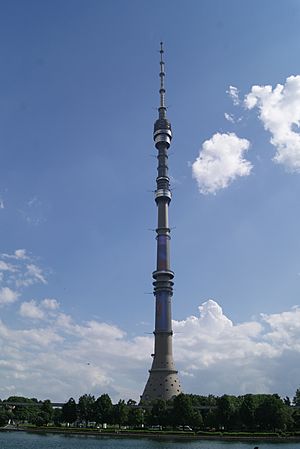
Perhaps the most recognizable contributions of the Stalinist period are the so-called Seven Sisters, comprising seven massive skyscrapers scattered throughout the city at about an equal distance from the Kremlin. A defining feature of Moscow’s skyline, their imposing form was allegedly inspired by the Manhattan Municipal Building in New York City, and their style—with intricate exteriors and a large central spire—has been described as Stalinist Gothic architecture. All seven towers can be seen from most high points in the city; they are among the tallest constructions in central Moscow apart from the Ostankino Tower, which, when it was completed in 1967, was the highest free-standing land structure in the world and today remains the world’s seventy-second tallest, ranking among buildings such as the Burj Khalifa in Dubai, Taipei 101 in Taiwan and the CN Tower in Toronto.
The Soviet goal of providing housing for every family, and the rapid growth of Moscow's population, led to the construction of large, monotonous housing blocks. Most of these date from the post-Stalin era and the styles are often named after the leader then in power (Brezhnev, Khrushchev, etc.). They are usually badly maintained.
Although the city still has some five-story apartment buildings constructed before the mid-1960s, more recent apartment buildings are usually at least nine floors tall, and have elevators. It is estimated that Moscow has over twice as many elevators as New York City and four times as many as Chicago. Moslift, one of the city's major elevator operating companies, has about 1500 elevator mechanics on call, to release residents trapped in elevators.
Stalinist-era buildings, mostly found in the central part of the city, are massive and usually ornamented with Socialist realism motifs that imitate classical themes. However, small churches – almost always Eastern Orthodox– found across the city provide glimpses of its past. The Old Arbat Street, a tourist street that was once the heart of a bohemian area, preserves most of its buildings from prior to the 20th century. Many buildings found off the main streets of the inner city (behind the Stalinist façades of Tverskaya Street, for example) are also examples of bourgeois architecture typical of Tsarist times. Ostankino Palace, Kuskovo, Uzkoye and other large estates just outside Moscow originally belong to nobles from the Tsarist era, and some convents and monasteries, both inside and outside the city, are open to Muscovites and tourists.
Attempts are being made to restore many of the city’s best-kept examples of pre-Soviet architecture. These restored structures are easily spotted by their bright new colors and spotless façades. There are a few examples of notable, early Soviet avant-garde work too, such as the house of the architect Konstantin Melnikov in the Arbat area. Many of these restorations were criticized for alleged disrespect of historical authenticity. Facadism is also widely practiced. Later examples of interesting Soviet architecture are usually marked by their impressive size and the semi-Modernist styles employed, such as with the Novy Arbat project, familiarly known as "false teeth of Moscow" and notorious for the wide-scale disruption of a historic area in central Moscow involved in the project.
Plaques on house exteriors will inform passers-by that a well-known personality once lived there. Frequently, the plaques are dedicated to Soviet celebrities not well known outside (or often, like with decorated generals and revolutionaries, now both inside) of Russia. There are also many "museum houses" of famous Russian writers, composers, and artists in the city.
Moscow's skyline is quickly modernizing, with several new towers under construction. In recent years, the city administration has been widely criticized for heavy destruction that has affected many historical buildings. As much as a third of historic Moscow has been destroyed in the past few years to make space for luxury apartments and hotels. Other historical buildings, including such landmarks as the 1930 Moskva hotel and the 1913 department store Voyentorg, have been razed and reconstructed anew, with the inevitable loss of historical value. Critics blame the government for not enforcing conservation laws: in the last 12 years more than 50 buildings with monument status were torn down, several of those dating back to the 17th century. Some critics also wonder if the money used for the reconstruction of razed buildings could not be used for the renovation of decaying structures, which include many works by architect Konstantin Melnikov and Mayakovskaya metro station.
Some organizations, such as Moscow Architecture Preservation Society and Save Europe's Heritage, are trying to draw the international public attention to these problems.
Parks and landmarks
There are 96 parks and 18 gardens in Moscow, including four botanical gardens. There are 450 square kilometres (170 sq mi) of green zones besides 100 square kilometres (39 sq mi) of forests. Moscow is a very green city, if compared to other cities of comparable size in Western Europe and North America; this is partly due to a history of having green "yards" with trees and grass, between residential buildings. There are on average 27 square meters (290 sq ft) of parks per person in Moscow compared with 6 for Paris, 7.5 in London and 8.6 in New York.
Gorky Park (officially the Central Park of Culture and Rest named after Maxim Gorky), was founded in 1928. The main part (689,000 square metres or 170 acres) along the Moskva river contains estrades, children's attractions (including the Observation Wheel water ponds with boats and water bicycles), dancing, tennis courts and other sports facilities. It borders the Neskuchny Garden (408,000 square metres or 101 acres), the oldest park in Moscow and a former imperial residence, created as a result of the integration of three estates in the 18th century. The Garden features the Green Theater, one of the largest open amphitheaters in Europe, able to hold up to 15 thousand people.
Several parks include a section known as a "Park of Culture and Rest", sometimes alongside a much wilder area (this includes parks such as Izmaylovsky, Fili and Sokolniki). Some parks are designated as Forest Parks (lesopark).
Izmaylovsky Park, created in 1931, is one of the largest urban parks in the world along with Richmond Park in London. Its area of 15.34 square kilometres (5.92 sq mi) is six times greater than that of Central Park in New York.
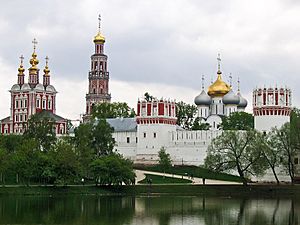
Sokolniki Park, named after the falcon hunting that occurred there in the past, is one of the oldest parks in Moscow and has an area of 6 square kilometres (2.3 sq mi). A central circle with a large fountain is surrounded by birch, maple and elm tree alleys. A labyrinth composed of green paths lies beyond the park's ponds.
Losiny Ostrov National Park ("Elk Island" National Park), with a total area of more than 116 square kilometres (45 sq mi), borders Sokolniki Park and was Russia's first national park. It is quite wild, and is also known as the "city taiga" – elk can be seen there.
Tsytsin Main Botanical Garden of Academy of Sciences, founded in 1945 is the largest in Europe. It covers territory of 3.61 square kilometres (1.39 sq mi) bordering the All-Russia Exhibition Center and contains a live exhibition of more than 20 thousand species of plants from around the world, as well as a lab for scientific research. It contains a rosarium with 20 thousand rose bushes, a dendrarium, and an oak forest, with the average age of trees exceeding 100 years. There is a greenhouse taking up more than 5,000 square metres (53,820 square feet) of land.
The All-Russian Exhibition Center (Всероссийский выставочный центр), formerly known as the All-Union Agricultural Exhibition (VSKhV) and later Exhibition of Achievements of the National Economy (VDNKh), though officially named a "permanent trade show", is one of the most prominent examples of Stalinist-era monumental architecture. Among the large spans of recreational park areas are scores of elaborate pavilions, each representing either a branch of Soviet industry and science or a USSR republic. Even though during the 1990s it was, and for some part still is, misused as a gigantic shopping center (most of the pavilions are rented out for small businesses), it still retains the bulk of its architectural landmarks, including two monumental fountains (Stone Flower and Friendship of Nations) and a 360 degrees panoramic cinema. In 2014 the park returned to the name Exhibition of Achievements of National Economy, and in the same year huge renovation works had been started. Lilac Park, founded in 1958, has a permanent sculpture display and a large rosarium.
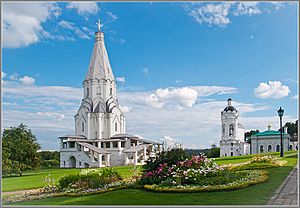
Moscow has always been a popular destination for tourists. Some of the more famous attractions include the city's UNESCO World Heritage Site, Moscow Kremlin and Red Square, which was built between the 14th and 17th centuries. The Church of the Ascension at Kolomenskoye, which dates from 1532, is also a UNESCO World Heritage Site and another popular attraction.
Near the new Tretyakov Gallery there is a sculpture garden, Museon, often called "the graveyard of fallen monuments" that displays statues of the former Soviet Union that were removed from their place after its dissolution.
Other attractions include the Moscow Zoo, a zoological garden in two sections (the valleys of two streams) linked by a bridge, with nearly a thousand species and more than 6,500 specimens. Each year, the zoo attracts more than 1.2 million visitors. Many of Moscow's parks and landscaped gardens are protected natural environments.
Moscow rings
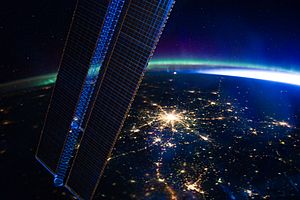
Moscow's road system is centered roughly on the Kremlin at the heart of the city. From there, roads generally span outwards to intersect with a sequence of circular roads ("rings").
The first and innermost major ring, Bulvarnoye Koltso (Boulevard Ring), was built at the former location of the 16th-century city wall around what used to be called Bely Gorod (White Town). The Bulvarnoye Koltso is technically not a ring; it does not form a complete circle, but instead a horseshoe-like arc that begins at the Cathedral of Christ the Savior and ends at the Yauza River.
The second primary ring, located outside the bell end of the Boulevard Ring, is the Sadovoye Koltso (Garden Ring). Like the Boulevard Ring, the Garden Ring follows the path of a 16th-century wall that used to encompass part of Moscow.
The third ring, the Third Transport Ring, was completed in 2003 as a high-speed freeway.
The Fourth Transport Ring, another freeway, is cancelled in 2011.
Aside from aforementioned hierarchy, line 5 of Moscow Metro is a circle-shaped looped subway line (hence the name Koltsevaya Liniya, "ring line"), which is located between the Sadovoye Koltso and Third Transport Ring.
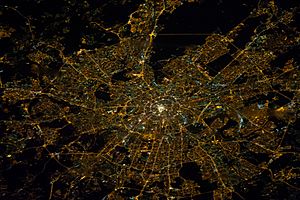
September 10, 2016, Moscow Central Circle renovated railroad (former Moskovskaya Okruzhnaya Zheleznaya Doroga) was introduced as 14th line of Moscow Metro. The railroad itself was in use since 1907, but before the renovation it was a non-electrified railroad for transit needs of fueled locomotives only.
The outermost ring within Moscow is the Moscow Ring Road (often called MKAD, acronym word for Russian Московская Кольцевая Автомобильная Дорога), which forms the cultural boundary of the city, was established in the 1950s. It is to note the method of building the road (usage of ground elevation instead of concrete columns throughout the whole way) formed a wall-like barrier that obstacles building roads under the MKAD highway itself).
Before 2012 expansion of Moscow, MKAD was considered an approximate border for Moscow boundaries.
Outside Moscow, some of the roads encompassing the city continue to follow this circular pattern seen inside city limits, with notable example of Betonka road, originally made of concrete pads.
Life and culture
Overview
One of the most notable art museums in Moscow is the Tretyakov Gallery, which was founded by Pavel Tretyakov, a wealthy patron of the arts who donated a large private collection to the city. The Tretyakov Gallery is split into two buildings. The Old Tretyakov gallery, the original gallery in the Tretyakovskaya area on the south bank of the Moskva River, houses works in the classic Russian tradition. The works of famous pre-Revolutionary painters, such as Ilya Repin, as well as the works of early Russian icon painters can be found here. Visitors can even see rare originals by early 15th-century iconographer Andrei Rublev.
The New Tretyakov gallery, created in Soviet times, mainly contains the works of Soviet artists, as well as of a few contemporary paintings, but there is some overlap with the Old Tretyakov Gallery for early 20th-century art. The new gallery includes a small reconstruction of Vladimir Tatlin's famous Monument to the Third International and a mixture of other avant-garde works by artists like Kazimir Malevich and Wassily Kandinsky. Socialist realism features can also be found within the halls of the New Tretyakov Gallery.
Another art museum in the city of Moscow is the Pushkin Museum of Fine Arts, which was founded by, among others, the father of Marina Tsvetaeva. The Pushkin Museum is similar to the British Museum in London in that its halls are a cross-section of exhibits on world civilisations, with many copies of ancient sculptures. However, it also hosts paintings from every major Western era; works by Claude Monet, Paul Cézanne, and Pablo Picasso are present in the museum's collection.
The State Historical Museum of Russia (Государственный Исторический музей) is a museum of Russian history located between Red Square and Manege Square in Moscow. Its exhibitions range from relics of the prehistoric tribes inhabiting present-day Russia, through priceless artworks acquired by members of the Romanov dynasty. The total number of objects in the museum's collection numbers is several million. The Polytechnical Museum, founded in 1872 is the largest technical museum in Russia, offering a wide array of historical inventions and technological achievements, including humanoid automata from the 18th century and the first Soviet computers. Its collection contains more than 160,000 items. The Borodino Panorama museum located on Kutuzov Avenue provides an opportunity for visitors to experience being on a battlefield with a 360° diorama. It is a part of the large historical memorial commemorating the victory in the Patriotic War of 1812 over Napoleon’s army, that includes also the triumphal arch, erected in 1827. There is also a military history museum that includes statues, and military hardware.
Moscow is the heart of the Russian performing arts, including ballet and film, with 68 museums 103 theaters, 132 cinemas and 24 concert halls. Among Moscow’s theaters and ballet studios is the Bolshoi Theatre and the Malyi Theatre as well as Vakhtangov Theatre and Moscow Art Theatre.
The Moscow International Performance Arts Center, opened in 2003, also known as Moscow International House of Music, is known for its performances in classical music. It has the largest organ in Russia installed in Svetlanov Hall.
There are also two large circuses in Moscow: Moscow State Circus and Moscow Circus on Tsvetnoy Boulevard named after Yuri Nikulin.
Memorial Museum of Astronautics under the Monument to the Conquerors of Space in the end of Cosmonauts Alley is the central memorial place for the Russian space officials.
The Mosfilm studio was at the heart of many classic films, as it is responsible for both artistic and mainstream productions. However, despite the continued presence and reputation of internationally renowned Russian filmmakers, the once prolific native studios are much quieter. Rare and historical films may be seen in the Salut cinema, where films from the Museum of Cinema collection are shown regularly.
The Shchusev State Museum of Architecture is the national museum of Russian architecture by the name of the architect Alexey Shchusev near the Kremlin area.
Entertainment
The city is full of clubs, restaurants and bars. Tverskaya Street is also one of the busiest shopping streets in Moscow.
The adjoining Tretyakovsky Proyezd, also south of Tverskaya Street, in Kitai-gorod, is host to upmarket boutique stores such as Bulgari, Tiffany & Co., Armani, Prada and Bentley. Nightlife in Moscow has moved on since Soviet times and today the city has many of the world's largest nightclubs. Clubs, bars, creative spaces and restaurants-turned-into-dancefloors are flooding Moscow streets with new openings every year. The hottest area is located around the old chocolate factory, where bars, nightclubs, galleries, cafés and restaurants are placed.
Politics
Moscow is the seat of power for the Russian Federation. At the centre of the city, in the Central Administrative Okrug, is the Moscow Kremlin, which houses the home of the President of Russia as well as national governmental facilities. This includes military headquarters and the headquarters of the Federal Security Service. Moscow, like with any national capital, is also the host of all the foreign embassies and diplomats representing a multitude of nations in Russia.
Moscow is designated as one of three federal cities of Russia – the others being Saint Petersburg and Sevastopol. Among the 85 federal subjects of Russia, Moscow represents the most populated one and the second-smallest one in terms of area. Moscow is located within the central economic region, one of twelve regions within Russia with similar economic goals. The basic law of the city is the Charter of Moscow that was adopted in 1995.
Sister cities
Moscow has many sister cities:
 Algiers, Algeria
Algiers, Algeria Almaty, Kazakhstan
Almaty, Kazakhstan Amman, Jordan
Amman, Jordan Ankara, Turkey
Ankara, Turkey Astana, Kazakhstan
Astana, Kazakhstan Athens, Greece
Athens, Greece Baku, Azerbaijan
Baku, Azerbaijan Bangkok, Thailand
Bangkok, Thailand Banja Luka, Bosnia and Herzegovina
Banja Luka, Bosnia and Herzegovina Beijing, China
Beijing, China Beirut, Lebanon
Beirut, Lebanon Belgrade, Serbia
Belgrade, Serbia Berlin, Germany
Berlin, Germany Brussels, Belgium
Brussels, Belgium Bucharest, Romania
Bucharest, Romania Cairo, Egypt
Cairo, Egypt Chicago, Illinois, United States
Chicago, Illinois, United States Cusco, Peru
Cusco, Peru Delhi, India
Delhi, India Donetsk, Ukraine
Donetsk, Ukraine Dubai, United Arab Emirates
Dubai, United Arab Emirates Dushanbe, Tajikistan
Dushanbe, Tajikistan Düsseldorf, Germany
Düsseldorf, Germany Ganja, Azerbaijan
Ganja, Azerbaijan Hanoi, Vietnam
Hanoi, Vietnam Havana, Cuba
Havana, Cuba Ho Chi Minh City, Vietnam
Ho Chi Minh City, Vietnam Ingolstadt, Germany
Ingolstadt, Germany Jelgava, Latvia
Jelgava, Latvia Kharkiv, Ukraine
Kharkiv, Ukraine Kolomna, Russia
Kolomna, Russia Kraków, Poland
Kraków, Poland Limoges, France
Limoges, France Ljubljana, Slovenia
Ljubljana, Slovenia
 London, England, United Kingdom
London, England, United Kingdom Madrid, Spain
Madrid, Spain Manila, Philippines
Manila, Philippines Naryan-Mar, Russia
Naryan-Mar, Russia Nicosia, Cyprus
Nicosia, Cyprus Paris, France
Paris, France Podgorica, Montenegro
Podgorica, Montenegro Prague, Czech Republic
Prague, Czech Republic Pyongyang, North Korea
Pyongyang, North Korea Rasht, Iran
Rasht, Iran Reykjavík, Iceland
Reykjavík, Iceland Riga, Latvia
Riga, Latvia Seoul, South Korea
Seoul, South Korea Tallinn, Estonia
Tallinn, Estonia Tel Aviv, Israel
Tel Aviv, Israel Tehran, Iran
Tehran, Iran Tirana, Albania
Tirana, Albania Tokyo, Japan
Tokyo, Japan Tunis, Tunisia
Tunis, Tunisia Ulan Bator, Mongolia
Ulan Bator, Mongolia Valenciennes, France
Valenciennes, France Vienna, Austria
Vienna, Austria Warsaw, Poland
Warsaw, Poland Yerevan, Armenia
Yerevan, Armenia
Images for kids
-
Saint Basil's Cathedral, built in 1561
-
Moskva riverfront in the 19th century
-
Napoleon retreating from the city during the Fire of Moscow, after the failed French Invasion of Russia
-
Cathedral Square during the coronation of Alexander I, 1802, by Fyodor Alekseyev
-
View of the Floating bridge in Zaryadye Park, with the Red Square and the Moscow Kremlin in the distance
-
VDNKh after rain
-
Saint Basil's Cathedral in Moscow, a masterpiece of Russian architecture
-
GUM department store, facing the Red Square
-
Modern methods of skyscraper construction were implemented in the city for the first time with the ambitious MIBC.
-
The Church of Ascension in Kolomenskoye is a World Heritage Site.
-
The Luzhniki Stadium hosted the 1980 Summer Olympics and the 2018 FIFA World Cup Final.
-
SC Olimpiyskiy was built for the 1980 Summer Olympics.
-
CSKA Arena during a game of KHL, considered to be the second-best ice hockey league in the world
-
The Luzhniki Stadium in Moscow, which hosted games of the 2018 FIFA World Cup
-
Moscow International Business Center, one of the largest financial centres of Europe and the world
-
Moscow has the largest fleet of electric buses in Europe, with 500 operating as of October 2020[update].
-
Cable cars passing across the Moskva River and the Luzhniki Stadium
-
The high-speed Sapsan train links Moscow with Saint Petersburg.
-
As of 2020[update], Moscow has the largest fleet of carsharing vehicles in the world, with more than 30,000 cars.
-
The 2020 development concept of Moscow International Business Center and its adjacent territory implies the construction of even more skyscrapers during the period of 2020–2027.
-
Otkrytiye Arena, home of FC Spartak Moscow
-
VEB Arena, home of PFC CSKA Moscow
-
VTB Arena, home of FC Dynamo Moscow and HC Dynamo Moscow
-
RZD Arena, home of FC Lokomotiv Moscow
-
Alexander Pushkin, the founder of modern Russian literature was born in Moscow in 1799.
-
Fyodor Dostoyevsky was born in Moscow in 1821.
-
Alexander Suvorov was born in Moscow in 1730.
-
Peter the Great was born in Moscow in 1672.
See also
 In Spanish: Moscú para niños
In Spanish: Moscú para niños


